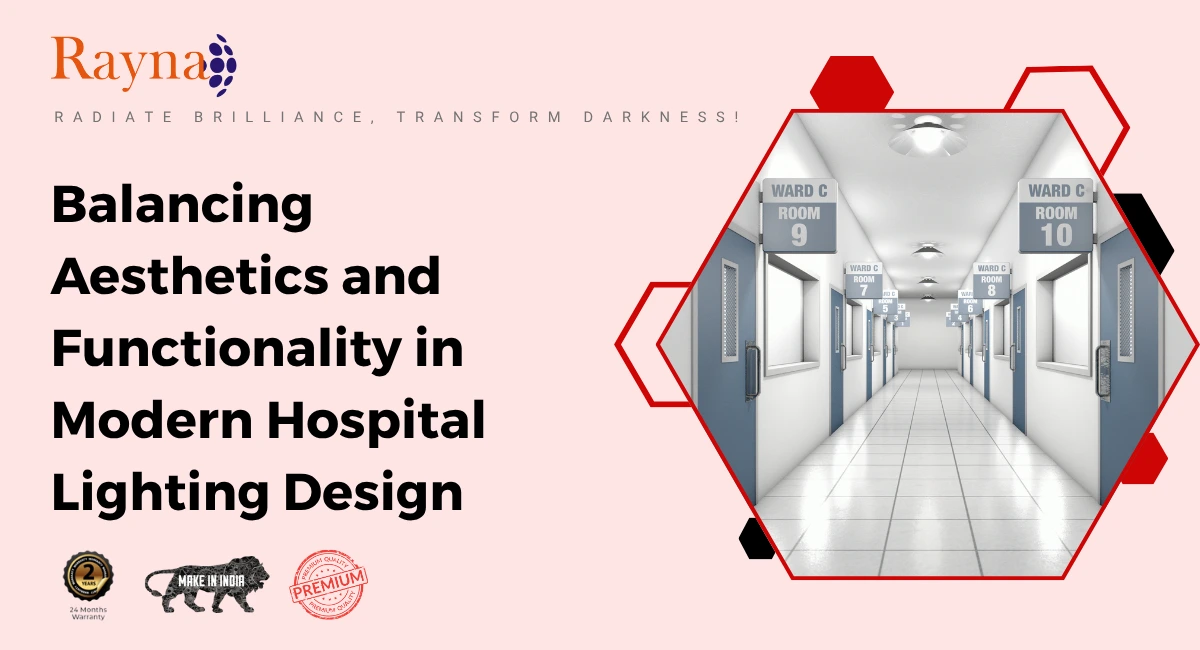


Discover how thoughtful hospital lighting design enhances healing, improves staff efficiency, and supports sustainability. Explore smart, energy-efficient lighting solutions by Rayna Industries.
Lighting is a foundational element in healthcare design, influencing not just visibility and safety, but also emotional comfort, healing, and operational efficiency. Hospitals today are more than treatment centers—they are dynamic environments where patients recover, healthcare professionals deliver critical services, and families seek reassurance.
Effective lighting must therefore bridge the gap between aesthetic quality and functional performance, shaping an environment that fosters healing while supporting day-to-day operations. Thoughtful hospital lighting design plays a central role in ensuring all these aspects are seamlessly integrated.
In clinical settings, lighting must fulfill a broad range of roles. It ensures accurate visual conditions for medical procedures, contributes to patient safety, and creates a welcoming ambiance for visitors. While function typically drives design in such spaces, aesthetics are increasingly recognised as vital to the overall experience. When thoughtfully executed, hospital lighting design can soften clinical harshness, transform perceptions, and elevate the hospital environment from sterile to soothing.
Aesthetics in hospital lighting design contribute to creating a sense of comfort and calm. Strategic use of light color, intensity, and fixture design can evoke positive emotions and reduce stress. For example, warm-toned lighting in patient rooms can create a more residential, less clinical feel, while indirect lighting in waiting areas can make long waits more tolerable.
Architectural hospital lighting design also allows hospitals to reinforce branding and identity. Incorporating daylight, where feasible, not only enhances well-being but reduces reliance on artificial lighting, boosting energy performance. Fixture styles, color temperatures, and lighting layouts can be tailored to reflect the institution's values and design philosophy.
Each zone within a hospital presents unique lighting needs. From high-intensity environments like operating rooms to more tranquil spaces such as patient wards, lighting must be adapted to suit diverse clinical and emotional requirements.
Surgical suites, procedure rooms, and diagnostic areas demand high-intensity, shadow-free illumination. These lights must provide excellent color accuracy—measured by a high Color Rendering Index (CRI)—to help clinicians distinguish subtle changes in tissue and skin tone during examinations or procedures. This is a crucial aspect of hospital lighting design in high-stakes environments.
In contrast, patient rooms benefit from more adaptable lighting systems. These should offer flexibility in brightness and color temperature to accommodate both clinical needs and patient comfort. Personal control over lighting can empower patients and contribute to improved mood, sleep, and recovery. These considerations form an important part of hospital lighting design for patient-centered care.
Ensuring safe movement throughout a facility is a critical function of hospital lighting design. Emergency exits, hallways, stairwells, and entrances must be well-illuminated at all times. Directional and wayfinding lighting helps reduce confusion and anxiety, making the hospital easier to navigate for all occupants.
Numerous studies point to the therapeutic effects of well-designed lighting. Exposure to natural daylight has been shown to enhance mood, reduce recovery time, and stabilise circadian rhythms. Integrating daylighting strategies with artificial lighting solutions can create a more humane, healing-focused atmosphere—especially important in long-term care units and intensive care areas. Hospital lighting design that mimics natural light patterns can significantly improve patient outcomes.
Circadian lighting systems, which adjust in intensity and color temperature throughout the day, help simulate the natural daylight cycle. These systems are particularly useful in windowless rooms or for patients undergoing extended stays, offering biological cues that aid in sleep regulation and emotional well-being.
Hospital personnel often work long shifts in high-pressure environments. Inadequate lighting can contribute to fatigue, reduce accuracy, and even affect morale. Areas such as nurse stations, labs, and offices require lighting that supports visual performance, concentration, and comfort. The importance of proper hospital lighting design in these areas cannot be overstated.
Tunable white lighting or dynamic systems that shift throughout the day can help align staff circadian rhythms with their work patterns, potentially improving alertness and reducing the impact of rotating shifts or night work.
With hospitals operating 24/7, energy consumption is a major operational concern. LED lighting has become the gold standard for energy efficiency, longevity, and low maintenance. These fixtures consume significantly less electricity and last far longer than traditional options. By choosing hospital lighting design that incorporates LED technology, healthcare facilities can drastically reduce energy costs.
Pairing LED technology with smart controls—such as motion sensors, daylight harvesting, and automated dimming—further enhances energy savings. This is especially effective in non-critical areas like storage rooms, hallways, and administrative spaces.
Sustainability in hospital lighting design also supports broader institutional goals. By incorporating daylight where possible and using renewable technologies, hospitals can reduce their environmental impact and operating costs simultaneously.
Advances in lighting technology continue to revolutionise hospital environments. IoT-enabled lighting systems allow facilities to monitor, adjust, and maintain lighting remotely—saving time and resources. Wireless control systems simplify installation and expand the adaptability of lighting throughout a building. The future of hospital lighting design lies in smarter, more responsive systems.
Tunable LED systems now allow precise control over light quality, supporting both circadian rhythm regulation and visual performance. Integration with building management systems means lighting can respond automatically to occupancy, time of day, or user preferences, ensuring optimal conditions at all times.
To ensure optimal lighting throughout a healthcare facility, it's important to match the right lighting products with the specific needs of each area. Here’s how different Rayna lighting solutions align with key hospital spaces and their unique functional and aesthetic requirements:
Browse all product categories or Contact our team for tailored recommendations.
In designing modern hospitals, it is no longer enough for lighting to simply serve a functional purpose. It must also support the emotional needs of patients, the efficiency of staff, and the overall identity of the facility. The most successful hospital lighting design strategies balance these competing needs, transforming utilitarian environments into spaces of comfort, healing, and hope.
As the demands on healthcare spaces evolve, so too must the approach to lighting. Embracing innovation, sustainability, and human-centered design principles will ensure hospitals remain functional, efficient, and welcoming for all who walk through their doors.
Looking to implement innovative hospital lighting design in your hospital project?
Reach out to our team to explore customised solutions tailored to your facility’s unique needs.
Let’s talk about how Rayna Industries can help you achieve your energy-efficient lighting goals for modern healthcare facilities. Whether you're designing a new hospital or upgrading an existing one, our LED solutions are built to balance performance, sustainability, and style.
Want all the details at a glance?
Download our product brochure to view specs, dimensions, and application id
Explore our full product range or place a bulk inquiry by visiting our website: www.raynaled.com
Email us: sales@raynaled.com
Call us: +91 7874847575
Ahmedabad Office:
1-Skylon Tower, University Road, Ahmedabad-380015
Factory Address:
Prabhunagar, Talod, Sabarkantha, Gujarat – 383215
Follow us on Facebook and check our Google Business Profile
Rayna Industries – Powering the Nation, One Light at a Time.
Energy-Saving. Smart. Made in India.
Sign Up Our Newsletter And Get Latest Updates